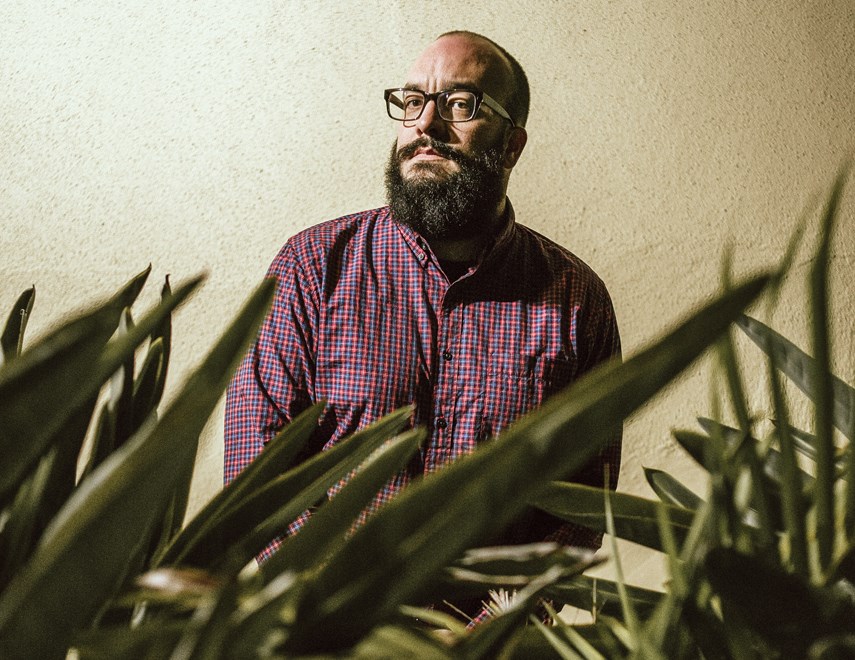Lowlife (USA 2017, directed by Ryan Prows. Screening at International Village 10 on Saturday, Sept. 30 at 4:30 p.m. and at the Rio Theatre on Monday, Oct. 2 at 9:15 p.m. as part of the Vancouver International Film Festival. For more details visit viff.org.
If the Values section of your date’s eHarmony profile includes Mexican wrestling, crime anthologies, or blood-soaked cinematic social justice, there is no better date movie than Lowlife.
“It’s an American issues movie wrapped up in a Luchador story in a weird crime movie to boot,” explains director Ryan Prows.
Lowlife opens with a villain who might’ve been dreamed into existence by the collective id of a Donald Trump rally. Outside a fleabag Los Angeles hotel he rounds up a group of Mexicans. We don’t know if they’re in the country illegally and neither does he.
As he holds them at gunpoint, we note the letters ICE on his bulletproof vest.
There was a time when Prows was concerned audiences wouldn’t know ICE stood for Immigration and Customs Enforcement. “We were unfortunately a little bit ahead of the curve,” he says with a laugh.
The movie was shot over 18 days early in 2016. Trump wasn’t yet president but both the man and the border wall were “definitely in the air,” Prows notes.
Following the motel roundup, we witness a scene of vile brutality.
And from that darkness we cut to: El Monstruo.
El Monstruo is either delusional, or, as he explains in an arresting monologue, he is an unworthy, undersized, rage-filled wrestler whose gargantuan father bequeathed him an oversized legacy as a champion of the downtrodden and a phantasm of justice.
Seemingly a graduate of the Tom Hardy school for thespians with their face covered, actor Richard Adam Zarate alternates between dignified and delirious from behind his Luchador mask.
From El Monstruo we jump to a marriage marred by substance abuse, featuring Nicki Micheaux in a strong performance as a fleabag motel proprietor trying to save someone who maybe can’t be saved. It’s an abrupt tone shift as we sink into a depressing room and feel the spirit of irreverence drain away.
Lowlife was initially slated to be a crime anthology featuring standalone stories. But as the script developed, Prows and his co-writers found their stories dovetailing and overlapping.
Having formed friendships at the American Film Institute and bonded over their love of genre cinema, the writers (formerly known the sketch comedy group Tomm Fondle) decided to make the jump to feature films.
“The good thing with five writers . . . we’re fast,” Prows says.
Several of the film’s writers ended up acting in and producing the movie, which allowed quick rewrites during a cramped 18-day shooting schedule, Prows explains.
Asked about raising money, Prows laughs.
“You’ve seen the movie,” he replies. “The script read even crazier.”
After conventional attempts to get the cash proved, “pretty futile,” they ended up raising less than $500,000 internally.
“It was our first movie together so we all sort of banded together and did it.”
Lowlife premiered in Montreal before a raucous festival crowd at Fantasia, where it earned the attention of Vancouver International Film Festival associate director of programming Curtis Woloschuk.
“It was a film that was on everyone’s lips,” he says. “You could just sense this, almost bloodlust, amongst the crowd.”
Woloschuk said he was impressed by the movie’s originality as well as its satire.
For Prows, the idea was to bring a political message “without soapboxing,” he says.
Prows opts for a handheld camera through much of the film. It’s not a found footage esthetic. Instead the camera shifts occasionally and almost imperceptibly, giving a hint of reality to a movie that otherwise might feel like a 1950s Luchador flick with a script doctored by Jim Thompson.
When the movie’s round plot comes full circle, we find ourselves following a mild-mannered accountant, a pregnant woman on the run and a newly released criminal with an unfortunate face tattoo who also has some of the best lines in the movie.
It’s at that point that a sense of dynamism kicks back in and we find ourselves wondering if this first time feature film director can stick the landing.
He does, and he does it by downplaying spectacle and bringing his characters to the forefront.
The movie’s outrageous characters “become increasingly humane as the film progresses,” Woloschuk observes.
And because these characters care, and because empathy isn’t subverted with a gag, we care too.
It’s something that worried Prows in Montreal. After laughing and cheering, the crowd seemed so “laser-focused” on the story’s dramatic beats he wondered if he’d done something wrong.
The tireless B-picture king Roger Corman once remarked: “You can’t make a cult film, the audience makes the cult film.”
Prows and co. have done their part. Now it’s for the crowd to decide.



